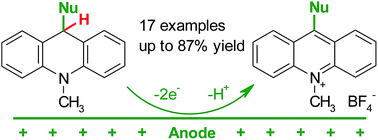C–H functionalization of azines. Anodic dehydroaromatization of 9-(hetero)aryl-9,10-dihydroacridines†
Abstract
Data on anodic dehydroaromatization of 9,10-dihydroacridines, bearing aryl and heteroaryl fragments, are presented. Effects of both electron-donating and electron-withdrawing substituents on the current–voltage characteristics of these compounds have been established. The experimental data proved to be in a good agreement with quantum chemical calculations. A simple and convenient method for the electrochemical conversion of dihydroacridines into the corresponding 9-(hetero)aryl-N-methylacridinium salts has been advanced.



 Please wait while we load your content...
Please wait while we load your content...